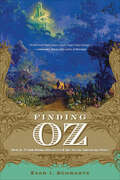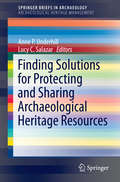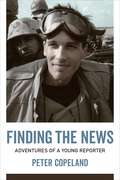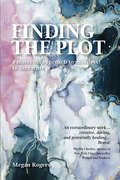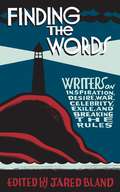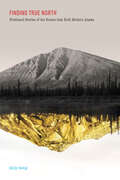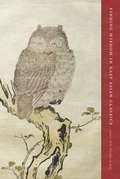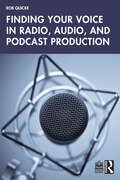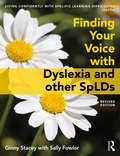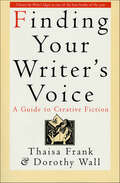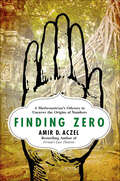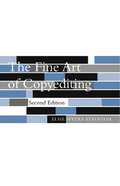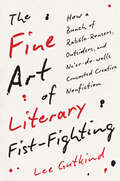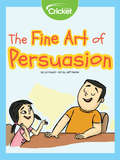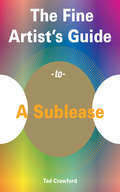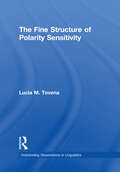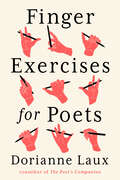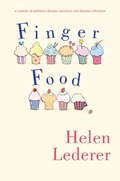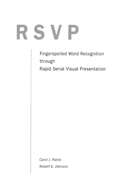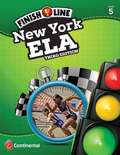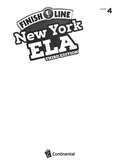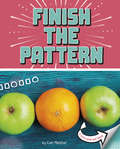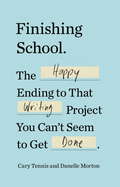- Table View
- List View
Finding Oz: How L. Frank Baum Discovered the Great American Story
by Evan I. SchwartzA groundbreaking new look at an American icon, The Wizard of Oz. Finding Oz tells the remarkable tale behind one of the world’s most enduring and best loved stories. Offering profound new insights into the true origins and meaning of L. Frank Baum’s 1900 masterwork, it delves into the personal turmoil and spiritual transformation that fueled Baum’s fantastical parable of the American Dream. Prior to becoming an impresario of children’s adventure tales—the J. K. Rowling of his age—Baum failed at a series of careers and nearly lost his soul before setting out on a journey of discovery that would lead to the Land of Oz. Drawing on original research, Evan Schwartz debunks popular misconceptions and shows how the people, places, and events in Baum’s life gave birth to his unforgettable images and characters. The Yellow Brick Road was real, the Emerald City evoked the Chicago World’s Fair of 1893, and Baum’s mother-in-law, the radical women’s rights leader Matilda Joslyn Gage, inspired his dual view of witches—as good and wicked. A narrative that sweeps across late nineteenth-century America, Finding Oz ultimately reveals how failure and heartbreak can sometimes lead to redemption and bliss, and how one individual can ignite the imagination of the entire world.
Finding Solutions for Protecting and Sharing Archaeological Heritage Resources
by Anne P. Underhill Lucy C. SalazarThis volume provides case studies about successful strategies employed in diverse world areas for the protection of archaeological heritage resources. Some chapters focus on a search for solutions arrived at by diverse groups of people working in specific areas rather than simply describing loss of cultural heritage. Other chapters provide a long-term view of intensified efforts at protection of archaeological resources. The authors describe challenges and solutions derived by concerned people in eastern Asia (China, Japan, Thailand), West Africa, Easter Island, Jordan, Honduras and more than one area of Peru. All of the authors draw upon deep, personal involvement with the protection of cultural heritage in each area. This volume is a timely addition to a growing number of conferences and publications about the management of cultural heritage--both archaeological and historical.
Finding the News: Adventures of a Young Reporter
by Peter CopelandFinding the News tells Peter Copeland’s fast-paced story of becoming a distinguished journalist. Starting in Chicago as a night police reporter, Copeland went on to work as a war correspondent in Latin America, the Middle East, and Africa before covering national politics in Washington, DC, where he rose to be bureau chief of the E. W. Scripps Company. The lessons he learned about accuracy and fairness during his long career are especially relevant today, given widespread concerns about the performance of the media, potential bias, and the proliferation of so-called “fake news.” He offers an honest and revealing narrative, told with surprising humor, about how he learned the craft of news reporting.Copeland’s story begins in 1980, when a colleague hastily declared him a full-fledged reporter after barely four days of training. He went on to learn the business the old-fashioned way: by chasing the news in thirty countries and across five continents. As a young person entering journalism and reporting during some of recent history’s most fraught military situations— including Operation Desert Storm and the US invasions of Panama and Somalia—Copeland discovered the craft was his calling. Looking back on his career, Copeland asserts his most important lessons were not about reporting, writing, or the latest technologies, but about the core values that underlie quality journalism: accuracy, fairness, and speed. Replete with behind-the-scenes stories about learning the trade, Copeland’s inspiring account builds into a heartfelt defense of journalism “done the right way” and serves as a call to action for today’s reporters. The values he learned as a cub reporter are needed now more than ever, he argues, as the integrity and motives of even seasoned journalists are called into question by political partisans. Copeland admits that those critics are not entirely wrong but contends that exciting new technologies, combined with a return to old-school news values, could usher in a golden age of journalism.
Finding the plot: A Maternal Approach to Madness in Literature
by Megan RigersOver the past fifty years, feminist literary criticism has become theoretical rather than practical, severing any relationship between literary analysis and the real lived experiences of women. An example of this disconnect is the way in which the madwoman in feminist literature has become a lauded icon of liberation, when in reality her situation would be seen as anything but empowered. Finding the Plot takes this example to task, arguing that in fact any interpretation of women’s madness as subversive reinforces the very gender stereotypes that feminist literary criticism should be calling into question.
Finding the Words: Writers on Inspiration, Desire, War, Celebrity, Exile, and Breaking the Rules
by Jared BlandCelebrated writers reveal surprising truths about the joys, challenges, and importance of finding the words, in this special fundraising anthology for PEN Canada. In Finding the Words, thirty-one well-known writers share deeply personal discoveries and stories that will surprise, delight, and stir the mind and heart. By turns inspiring, provocative, witty, and compelling, these diverse and original pieces explore home, exile, and the search for a place to belong; community, creativity, celebrity, and the many forms power can take. Among the pieces in the anthology: Diana Athill and Alice Munro discuss the consequences of writing about other people; Gord Downie meditates on what it means to be a songwriter by considering one of his own songwriting heroes; Guy Gavriel Kay reflects on how his relationship with his own readers continues to change; Elizabeth Hay searches for inspiration in the fallow period between books; Rawi Hage meditates on writing rooted in the universal experience of exile; Pasha Malla and Moez Surani present a funny and confounding list of "rules for writers" solicited from non-writers; Heather O'Neill tells the story of an illiterate and underage wannabe gangster in mid-century Montreal; Michael Winter pieces together court transcripts, newspaper accounts, and other primary sources to take us into the dark heart of a real-life Newfoundland crime story. Proceeds from this volume will go to PEN Canada in support of its vital work in defence of freedom of expression and on behalf of writers around the world who have been silenced. Finding the Words Contributors List:Diana AthillTash AwDavid Bezmozgis Joseph Boyden David Chariandy Denise ChongKaren Connelly Alain de Botton Emma Donoghue Gord Downie Marina Endicott Stacey May Fowles Rawi Hage Elizabeth Hay Steven Heighton Lee Henderson Guy Gavriel Kay Mark Kingwell Martha Kuwee Kumsa Annabel Lyon Linden MacIntyre Pasha Malla Lisa Moore Alice Munro Stephanie Nolen Heather O'Neill Richard Poplak Moez Surani Miguel Syjuco Madeleine Thien Michael Winter With cover design and illustration by Sethwww.pencanada.caFrom the Trade Paperback edition.
Finding True North: First-Hand Stories of the Booms that Built Modern Alaska
by Molly RettigMelting sea ice and rumbling volcanoes. Sled dogs racing through unnamed valleys. These were the images that came to mind when Molly Rettig moved to Fairbanks, Alaska to work as a reporter at the local newspaper. An avid environmentalist, she couldn’t wait to explore the vast, untamed spaces that had largely been paved over on the east coast. But when her 72-year-old neighbor, Clutch, invites her on a tour of his gold mine—an 800-foot tunnel blasted into the side of his house–she begins to question many of her ideas about Alaska, and about herself. In Finding True North, Rettig takes us on a gripping journey through Alaska's past that brings alive the state's magnificent country and its quirky, larger-than-life characters. She meets a trapper who harvests all she needs from the land, a bush pilot who taught himself how to fly, and an archaeologist who helped build an oil pipeline through pristine wilderness. While she learns how airplanes, mines, and oil fields have paved the way for newcomers like herself, she also stumbles upon a bigger question: what has this quest for Alaska’s natural resources actually cost, and how much more is at stake? This is a book about all the ways wild places teach us about ourselves. Rettig writes both playfully and honestly about how one place can be many things to many people—and how all of it can be true.
Finding Wisdom in East Asian Classics
by De Bary Wm. Theodore Ed.Finding Wisdom in East Asian Classics is an essential, all-access guide to the core texts of East Asian civilization and culture. Essays address frequently read, foundational texts in Chinese, Japanese, Korean, and Vietnamese, as well as early modern fictional classics and nonfiction works of the seventeenth century. Building strong links between these writings and the critical traditions of Confucianism, Buddhism, and Daoism, this volume shows the vital role of the classics in the shaping of Asian history and in the development of the humanities at large.Wm. Theodore de Bary focuses on texts that have survived for centuries, if not millennia, through avid questioning and contestation. Recognized as perennial reflections on life and society, these works represent diverse historical periods and cultures and include the Analects of Confucius, Mencius, Laozi, Xunxi, the Lotus Sutra, Tang poetry, the Pillow Book, The Tale of Genji, and the writings of Chikamatsu and Kaibara Ekken. Contributors explain the core and most commonly understood aspects of these works and how they operate within their traditions. They trace their reach and reinvention throughout history and their ongoing relevance in modern life. With fresh interpretations of familiar readings, these essays inspire renewed appreciation and examination. In the case of some classics open to multiple interpretations, de Bary chooses two complementary essays from different contributors. Expanding on debates concerning the challenges of teaching classics in the twenty-first century, several pieces speak to the value of Asia in the core curriculum. Indispensable for early scholarship on Asia and the evolution of global civilization, Finding Wisdom in East Asian Classics helps one master the major texts of human thought.
Finding Your Voice in Radio, Audio, and Podcast Production
by Rob QuickeThis book provides a unique identity-centered approach to radio, audio, and podcast production which encourages readers to build their confidence and create audio content that matters to them. Written for those just starting out in audio production and focusing on the process of their self-development, readers will learn how to use sound to express themselves in a variety of ways and to create powerful stories in the process – all with the tools already available to them. At the centre of this approach is the author’s R.E.A.L. method, referring to the creation of audio that is relatable, engaging, authentic, and liberating. Students will learn to apply this concept to each step of the production process, from planning and writing through to interviewing, broadcasting, and responding to feedback. By the end of this book readers will have developed a working knowledge of podcast, audio, and radio production alongside their own means of self-expression. Supported by exercises and interviews with audio practitioners throughout, Finding Your Voice in Radio, Audio, and Podcast Production is a key resource for anyone approaching radio, audio, or podcasting for the first time. A supporting companion website with Instructor and Student Resources is available at www.robquicke.com.
Finding Your Voice with Dyslexia and other SpLDs
by Ginny Stacey Sally FowlerFinding Your Voice with Dyslexia and other SpLDs is an essential guide to living with dyslexia and other specific learning difficulties (SpLDs). The book provides readers with a practical guide to expressing and developing ideas and feelings. Uniquely designed for dyslexic/ SpLD readers, this book discusses how individual people function and will help readers to: •understand how they think•know what they can do to maintain clear thinking•know how they can positively contribute to any situation in which they find themselves.When people with SpLD find their voice, they gain the self-esteem and confidence to tackle all elements of life (study, employment, general living) and to negotiate sucessfully with those around them. The book contains stories, insights, examples, tips and exercises, presented in a user-friendly way throughout. The book has also been designed for non-linear reading and each chapter includes a ‘dipping-in’ section to guide the reader. The book does not have to be read as solid, continuous text from start to finish: it can be read more like a travel guide.As well as providing vital assistance to people with dyslexia and other specific learning difficulties, this book will benefit anyone supporting, living or working with dyslexic/ SpLD people by helping them to understand more about the dyslexic/ SpLD world.
Finding Your Writer's Voice: A Guide to Creative Fiction
by Thaisa Frank Dorothy WallAn illuminating guide to finding one's most powerful writing tool, Finding Your Writer's Voice helps writers learn to hear the voices that are uniquely their own. Mixing creative inspiration with practical advice about craft, the book includes chapters on:Accessing raw voiceListening to voices of childhood, public and private voices, and colloquial voicesWorking in first and third person: discovering a narrative personaUsing voice to create charactersShaping one's voice into the form of a storyReigniting the energy of voice during revision
Finding Zero: A Mathematician's Odyssey to Uncover the Origins of Numbers
by Amir D. Aczel“A captivating story, not just an intellectual quest but a personal one . . . gripping [and] filled with the passion and wonder of numbers.” —The New York TimesVirtually everything in our lives is digital, numerical, or quantified. But the story of how and where we got these numerals, which we so depend on, has for thousands of years been shrouded in mystery. Finding Zero is the saga of Amir Aczel’s lifelong obsession: to find the original sources of our numerals, perhaps the greatest abstraction the human mind has ever created.Aczel has doggedly crisscrossed the ancient world, scouring dusty, moldy texts, cross-examining so-called scholars who offered wildly differing sets of facts, and ultimately penetrating deep into a Cambodian jungle to find a definitive proof. Here, he takes the reader along for the ride.The history begins with Babylonian cuneiform numbers, followed by Greek and Roman letter numerals. Then Aczel asks: Where do the numbers we use today, the so-called Hindu-Arabic numerals, come from? It is this search that leads him to explore uncharted territory on a grand quest into India, Thailand, Laos, Vietnam, and ultimately into the wilds of Cambodia. There he is blown away to find the earliest zero—the keystone of our entire system of numbers—on a crumbling, vine-covered wall of a seventh-century temple adorned with eaten-away erotic sculptures.While on this odyssey, Aczel meets a host of fascinating characters: academics in search of truth, jungle trekkers looking for adventure, surprisingly honest politicians, shameless smugglers, and treacherous archaeological thieves—who finally reveal where our numbers come from.“A historical adventure that doubles as a surprisingly engaging math lesson . . . rip-roaring exploits and escapades.” —Publishers Weekly
The Fine Art of Copyediting: Including Advice To Editors On How To Get Along With Authors, And Tips On Style For Both
by Elsie Myers StaintonMany stylebooks and manuals explain writing, but before the release ten years ago of Elsie Myers Stainton's The Fine Art of Copyediting, few addressed the practices and problems of editing. This handbook has guided users through the editing process for books and journals, with tips on how to be diplomatic when recommending changes, how to edit notes and bibliographies, how to check proofs, and how to negotiate the ethical, intellectual, and emotional problems characteristic of the editorial profession. Now featuring solid advice on computer editing and a new chapter on style, as well as more information on references, bibliographies, indexing, and bias-free writing, The Fine Art of Copyediting, Second Edition offers the same wealth of information that prompted William Safire to commend the first edition in The New York Times Magazine.Complete with helpful checklists for the manuscript, proof, and index stages of book production, as well as an excellent bibliography of reference works useful to the copyeditor, The Fine Art of Copyediting, Second Edition is an indispensable desk reference for writers and editors confronting a host of questions each day. Why use the word "people" instead of "persons?" What precautions are necessary for publishers to avoid libel suits? How can an editor win an author's trust? What type fonts facilitate the copyediting process? How does computer editing work? For experienced and novice copyeditors, writers and students, this is the source for detailed, step-by-step guidance to the entire editorial process.
The Fine Art of Copyediting (2nd Edition)
by Elsie Myers StaintonIncludes Advice To Editors On How To Get Along With Authors, And Tips On Style For Both.
The Fine Art of Literary Fist-Fighting: How a Bunch of Rabble-Rousers, Outsiders, and Ne'er-do-wells Concocted Creative Nonfiction
by Lee GutkindAn account of the emergence of creative nonfiction, written by the &“godfather&” of the genre In the 1970s, Lee Gutkind, a leather-clad hippie motorcyclist and former public relations writer, fought his way into the academy. Then he took on his colleagues. His goal: to make creative nonfiction an accepted academic discipline, one as vital as poetry, drama, and fiction. In this book Gutkind tells the true story of how creative nonfiction became a leading genre for both readers and writers. Creative nonfiction—true stories enriched by relevant ideas, insights, and intimacies—offered liberation to writers, allowing them to push their work in freewheeling directions. The genre also opened doors to outsiders—doctors, lawyers, construction workers—who felt they had stories to tell about their lives and experiences. Gutkind documents the evolution of the genre, discussing the lives and work of such practitioners as Joan Didion, Tom Wolfe, Norman Mailer, James Baldwin, Zora Neale Hurston, Rachel Carson, Upton Sinclair, Janet Malcolm, and Vivian Gornick. Gutkind also highlights the ethics of writing creative nonfiction, including how writers handle the distinctions between fact and fiction. Gutkind&’s book narrates the story not just of a genre but of the person who brought it to the forefront of the literary and journalistic world.
The Fine Art of Persuasion
by Liz HuyckDo you ever have trouble getting someone to agree with you on something? Reaching your goals can sometimes be hard if someone doesn't see eye-to-eye with you! Learn some tips to improve your persuasion skills as you follow along with two children as they try to convince their parents to get a family pet.
The Fine Artist's Guide to A Sublease
by Tad CrawfordPart of The Fine Artist's Guide series, this classic guide provides information about issues relevant to artists today. It explores several tactics for negotiating a beneficial sublease, how to reduce studio overhead through subletting, and the process of drafting a sublease. This guide demonstrates three types of leases (Form 20, 21, 22) and their provisions, includes a sample sublease contract, and contains helpful negotiation checklists.
A Fine Coat (Book 6)
by Barbara W. MakarDecodable Storybooks 2A accompany More Workbook 2 and provide additional opportunity to apply the phonetic concepts introduced in Workbook 2 to connected text. The storybooks use the same vocabulary as Workbook 2 and Storybooks 2 with the addition of one sight word was. Storybooks 2A are an excellent tool to reinforce the skills from Workbook 2 and can be used with either Workbook 2 or More Workbook 2"--Epsbooks.com.
The Fine Structure of Polarity Sensitivity (Outstanding Dissertations in Linguistics)
by Lucia M. TovenaFirst Published in 1998. Part of the Outstanding Dissertations in Linguistics series, this study investigates the phenomenon of polarity sensitivity. It proposes a new perspective which focuses on the behaviour and properties of sensitive items and the phrases they form. It originated in the observation that the fine structure of the phenomenon requires a more articulated analysis than the standard one based on licensing conditions.
Finger Exercises for Poets
by Dorianne LauxAn illuminating book of concise craft essays and exercises for poets, from Pulitzer Prize finalist and The Poet’s Companion coauthor Dorianne Laux. From “a poet of immense insight and masterful craft” (Kwame Dawes), Finger Exercises for Poets is an engaging and inspiriting invitation to practice poetry alongside one of its masters. With wide-ranging examples from classic and contemporary poets, Dorianne Laux demystifies the magic of language that makes great poetry and offers generative exercises to harness that magic. She explores the syllable and the line, the use of form, poetic responses to contemporary events and personal experiences, the imaginative leap, and the power of a distinct voice. As she writes in the introduction, “My instrument is the immensity of language.… There are eighty-eight keys on a piano, six hundred thousand words in the English language. The patterns, sequences, and permutations of both are endless. For me, language is another kind of music.… I practice poetry. This book invites you to practice along with me.” Throughout, Laux reminds us that poetry is a practice as much as an art and that poets must hone their language as a musician practicing an instrument.
Finger Food
by Helen LedererBella le Pard’s career as a TV presenter is ‘on hold’. To fill her days, she sits in a coffee shop and obsesses about a wedding dress in the neighbouring shop. Her luck changes when she gets the call from her old boss at ‘Flair for living TV’ to present a pilot for a new food and chat show. But her revived TV career is short-lived when one of the celebrity guests threatens to steal the show. Bella finds herself turning to blackmail to save her job. But will her threat to reveal her boss’s infidelity keep her on TV? And will she ever find a reason to buy that dream wedding dress?
Fingerspelled Word Recognition through Rapid Serial Visual Presentation
by Carol J. Patrie and Robert E. JohnsonRSVP can be used in the classroom or for self-study. Learning and practicing this extensively researched approach is the key to unlocking the mystery of understanding fingerspelling. [Carol J. Patrie, Robert E. Johnson; (2011) Book: 185 pages; soft cover; coil bound, CD-ROM, DVD: 187 minutes; no audio; Mac OS X 10.6; PC Windows 7] Item not returnable once opened. The book explains the form and function for the types of fingerspelling: careful, rapid and lexicalized.
Finish Line New York ELA: Grade 5 (Third Edition)
by Continental Press StaffNeed more standards support in your lesson plans? Finish Line New York ELA is the perfect fit with step-by-step instruction to help students take on the challenging nature of New York's Common Core Learning Standards (CCLS). This next generation of Finish Line includes 300+ pages of focused practice and a new lesson format. The gradual release model is extended to four parts to promote deeper learning: Skill Introduction, Focused Instruction, Guided Practice, and Independent Practice. Guided questions model the thought process. Language Arts/Writing is integrated into the book. A full unit of writing standards helps students practice the writing process, learn how to answer open-ended questions, and apply grammar and usage conventions. Much like New York's standards and assessments, students are required to do close reading of rigorous text. Reviews include PARCC-type items, as well as multiple-choice, open-ended, and multipart questions. Finish Line is designed to supplement core basal programs, including ReadyGEN(tm) and Common Core Code X(tm).
Finish Line New York ELA: Grade 4
by Continental Press StaffFinish Line New York ELA Third Edition Grade 4
Finish the Pattern: A Turn-and-See Book (What's Next?)
by Cari MeisterFrom the days of the week to playing hopscotch, patterns are all around you. Keep turning the pages to find out how your life is full of patterns and sequences.
Finishing School: The Happy Ending to That Writing Project You Can't Seem to Get Done
by Cary Tennis Danelle MortonAll too many people start a writing project with grand ambitions but reach a crisis of completion. Finishing School helps writers reignite the passion that started them on the project in the first place and work steadily to get it done. Untold millions of writing projects—begun with hope and a little bit of hubris—lie abandoned in desk drawers, in dated files on computer desktops, and in the far reaches of the mind. Too often, writers get tangled in self-abuse—their self-doubt, shame, yearning for perfection, and even arrogance get in the way. In Finishing School, Cary Tennis and Danelle Morton help writers overcome these emotional blocks and break down daunting projects into manageable pieces. Tennis first convened a Finishing School so that writers could help one another stay on track and complete their work. Since they weren’t actually critiquing one another’s writing, there was no jockeying for the title of best writer or the usual writing group politics; there was only a shared commitment to progress. Without guilt, blame, and outside critique, students were more productive than they imagined possible. Through this program, they were able to complete novels that they’d been struggling with for almost two decades, finish screenplays drafts, and revive interest in long-neglected PhD theses. In this book, the authors share this proven and easily replicable technique, as well as their own writing success stories.From the Trade Paperback edition.
